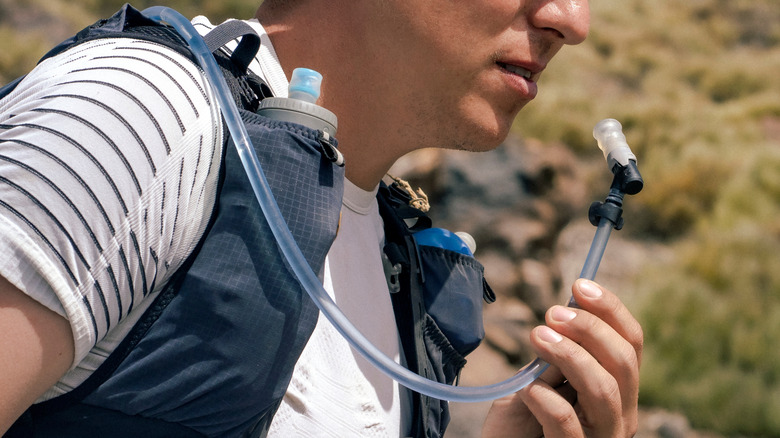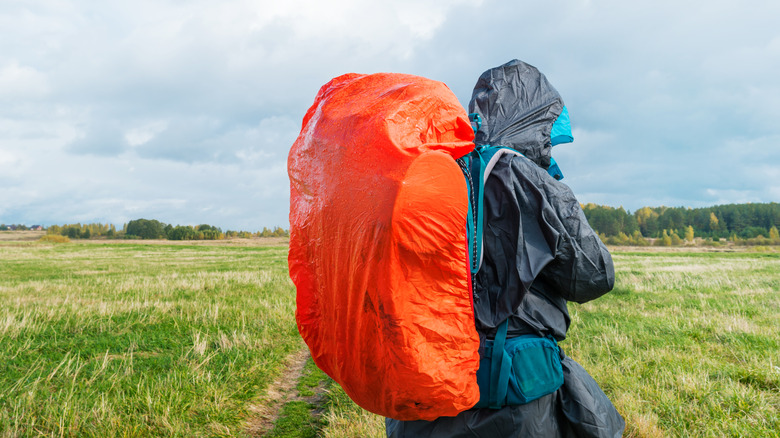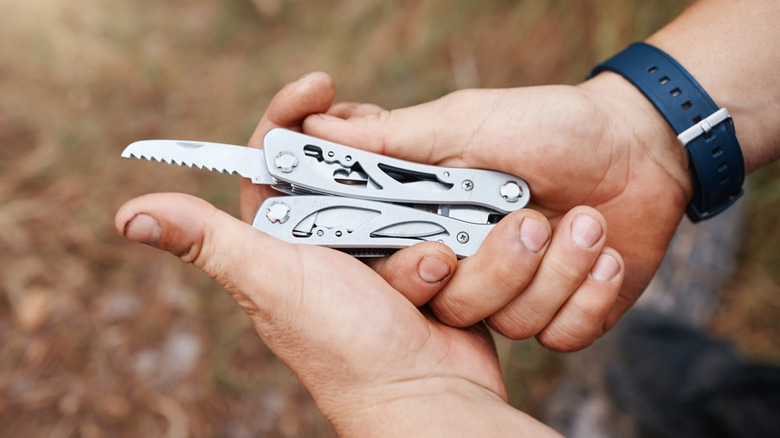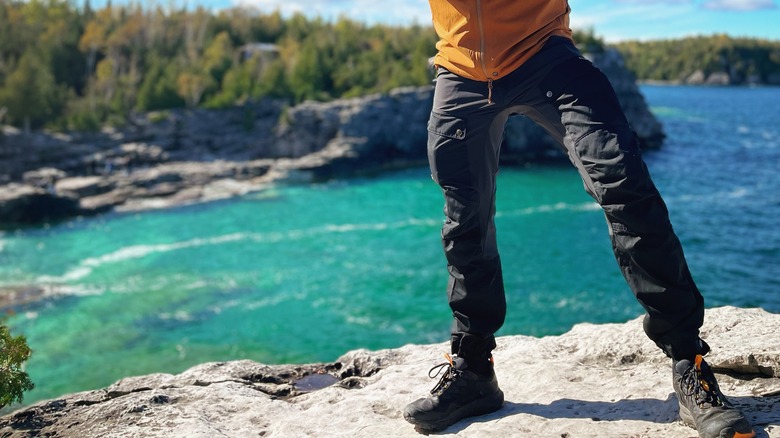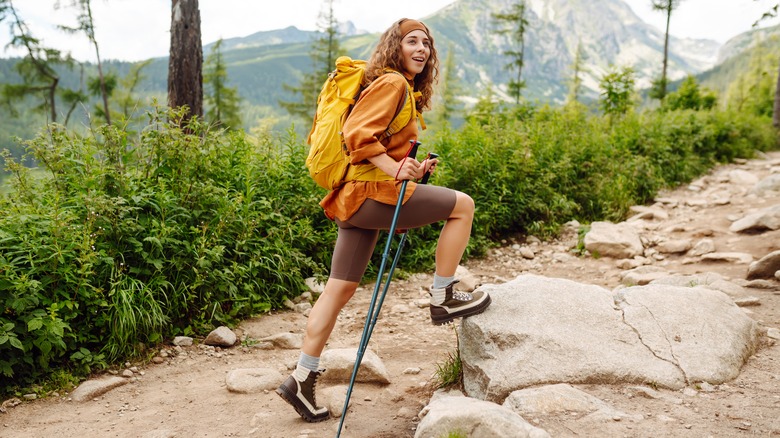Expensive Gear Upgrades That Are Less Useful And Unnecessary For The Average Hiker
We may receive a commission on purchases made from links.
Hiking is a phenomenal way to get exercise and experience the great outdoors. You can certainly enjoy some beautiful views on scenic drives through nature preserves, but nothing beats being totally immersed in nature far away from the nearest highway. In order to have your moment of solitude in the wilderness, you're probably going to have to take a nice hike.
Whether you're an avid trekker or a newbie in search of great beginner hiking trails, it can be tempting to splurge on state-of-the-art hiking gear. Some outdoor lovers refer to themselves as "gear addicts" because they're always purchasing the latest and greatest gadgets for hiking, camping, and backpacking — but some popular products that are marketed towards hikers simply aren't worth the money.
It's worth making a few investments if you're going on an extended backpacking expedition or a wild camping excursion, but for most day hikes, you can make do with simple and affordable essentials that you probably already have at home. Don't waste your money on expensive hiking products that aren't necessary.
Water bladders aren't as convenient as they look
Water bladders, also known as hydration packs, are crafted from a thin flexible plastic or rubber material. The bladder has a hose with a mouthpiece. Water bladders fit snugly within a hiking backpack and allow for hands-free hydration on the trail. But according to some outdoor experts, they're not worth the hype.
Chris Mercer is a backpacking enthusiast and the man behind Step Massive. He has a popular YouTube channel and a website where he discusses all things related to backpacking. Over the years, he has embarked on more than 120 solo backpacking expeditions — so it's safe to say he knows a thing or two about essential hiking gear. On his website, he calls water bladders "great in theory" but "annoying in reality" because they can easily become useless on the trail. If the bag leaks, all of your gear can get soaked. If you're hiking in cold weather, they can freeze, meaning you won't be able to get a drink until the hose thaws out. Furthermore, they are difficult to refill from natural bodies of water.
Instead of a hydration pack, opt for a lightweight water bottle that can fit in a side pocket on your backpack. You can still easily reach back and grab it for a drink on the go. Nalgene (Amazon) and Hydro Flask (Amazon) are a few brands that sell great water bottles for hiking. A collapsible water bottle is a great option if you're hoping to save space. You can even purchase water bottles with built-in filters to purify fresh water while you're hiking the woods. Grayl GeoPress (Amazon) is a popular option that filters out many viruses, protozoa, bacteria, chemicals, heavy metals, and particulate matter.
Fancy hiking backpacks with waterproof covers are unnecessary
There are so many beautiful hiking backpacks on the market, and it can be really tempting to splurge on one before embarking on a big outdoor adventure. But for most hikes, any lightweight backpack will do. Whether you're going on a short day hike or an extended trek into the backcountry, a backpack is an essential piece of gear, but you don't need to break the bank in order to choose the right version for your camping and hiking excursions.
Sheena is a photographer and outdoor enthusiast based out of Colorado who shares her hiking and adventure tips on her Substack "The Wilder Dispatch." She thinks that a "fancy, elaborate hiking pack" isn't worth the money if you're new to hiking. "Contrary to what the hiking blogs may tell you, a standard old backpack with a supporting waistband (to take some of the weight off your shoulders and upper back) will suffice for easier and intermediate hikes," she wrote.
Many high-end hiking backpacks come with a water resistant cover. You can also purchase them separately, but you probably don't need to. According to Chris Mercer on Step Massive, they aren't that effective at keeping water out of your pack. "In reality, pack covers are one of the most overrated pieces of backpacking gear. Not only do they fail to fully protect your pack, but they also add unnecessary cost, weight, and frustration," he wrote on his website. Instead, he suggests using a pack liner.
You probably won't need to use those heavy duty multi-tools
Many hikers like to stock up their backpack with a few essentials that could come in handy on the trail. A first aid kit, some snacks, a packable rain jacket, and plenty of water are all good things to have on hand. A multi-tool is another popular item to take hiking, but they're actually far less useful than most people realize. If you feel more comfortable having a tool on hand, feel free to bring one along — but there's certainly no need to splurge on the most expensive model.
Multi-tools usually contain some combination of knife blades, tweezers, bottle openers, pliers, and screwdrivers. Since so many different tools are combined, they're sometimes not the highest quality. Leatherman is one of the more popular brands of multi-tools, which you can purchase on Amazon. Top of the line models cost around $250 – so it's quite a big investment when you may not need most of the included tools.
Instead of a multi-tool, opt for a simple knife. A knife is most likely to come in handy during a hiking trip. You may use it for food prep, preparing wood for kindling, or even self-defense. Hiking knives can get expensive, but it's totally possible to find decent options for under $20. You'll want to opt for something lightweight and compact so that it doesn't add to the heaviness of your pack.
Special hiking pants with tons of pockets are overrated
Wearing comfortable clothes is a must for any hiking trip. Nothing ruins a great day on the trail faster than clothing that makes you want to crawl out of your skin. Even if you're going on an easy stroll through the forest, you're likely to sweat a bit on a warm summer day — so moisture-wicking clothing is a must. Damp clothing can cause chafing and blisters. Abrasive fabrics can rub you the wrong way, and anything that is too heavy will start to wear you down after a while.
It's best to choose clothing that is lightweight and designed for athletic activity when visiting a national park or other outdoor destination. Even so, you don't need to break the bank and purchase special pants that are designed for hiking unless you're going on a serious expedition or an extended backpacking trip.
"Hiking pants really come in handy for a few key scenarios, which typically don't apply when you're just starting out. They're a go-to item if you're doing longer, more strenuous hikes, but for easy to moderate ones without water crossings, wildly rainy weather, or rugged terrain, save your money," Sheena wrote in a post on The Wilder Dispatch. At the time of writing, the most expensive hiking pants on REI's website cost around $300. Most options cost between $50 and $200. Instead of splurging, consider wearing your usual workout pants or shorts. Moisture-wicking leggings work fine for most hikes.
Expensive trekking poles aren't any better than the affordable option
Whether or not to use hiking poles depends entirely on your personal preference. They're a great tool, but not every hiker enjoys using them. Those who prefer to hike without using poles usually don't like carrying the extra wait and prefer to have their hands free, whereas proponents of hiking poles love that they provide added stability on uneven terrain. They can also help avoid extra strain on your joints, which is especially great for hikers who suffer from knee pain. If you're trying to get a great workout on your hike, using hiking poles can help. They can increase your calorie burn by around 20% because you're working your upper body more, according to Outside Online.
If you decide to invest in some hiking poles for your next journey along the trail, keep in mind that high-end hiking poles can be extremely expensive. Leki makes hiking poles from sustainable materials that cost over $250, and Balenciaga sells some branded hiking poles for a jaw-dropping $450. You don't need to splurge on the most high-end models in order to get the benefits.
Costco sells a set that includes two pairs of hiking poles for about $90. They're a bargain, especially if you split the cost with your favorite hiking buddy. The Cascade Mountain Tech poles are crafted from carbon fiber. The height is adjustable from 26 inches to 54 inches so you can achieve the perfect custom height. The grip is made from cork, so it's super comfy. The affordable hiking poles have a cult following among experienced hikers. For more information on the best (and safest) hiking gear, check out our ultimate packing guide.

